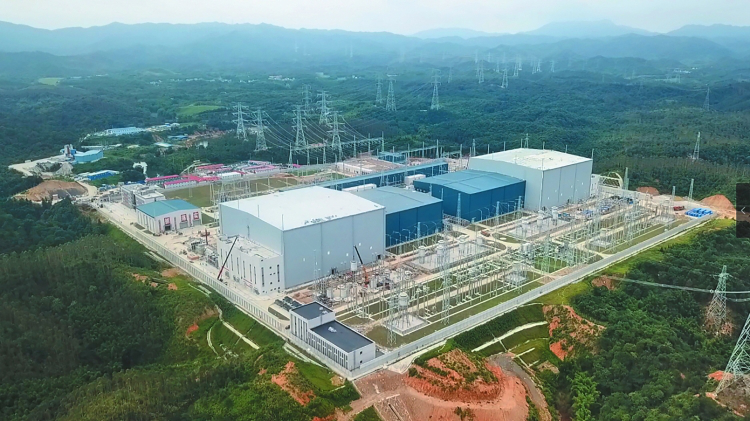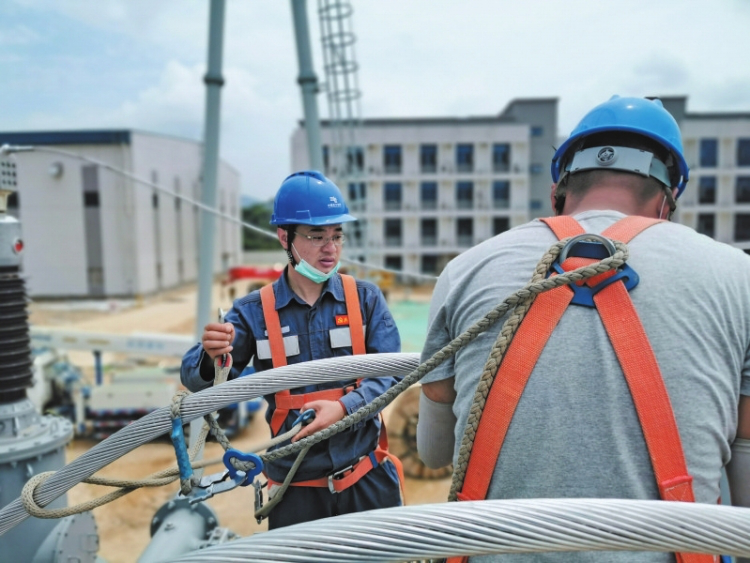from:China Southern Power Griddate:2020-11-02

The Longmen Converter Station (aerial photo on October 23).

Members of the preparation team test the system.

Members of the preparation team check the lead wires at the low-voltage ends of transformers used in power stations.
On October 1, the flag raising ceremony was held with the national anthem of the People’s Republic of China - March of the Volunteers - playing at Longmen Converter Station, the ±800 kV Guangdong receiving end of the Wudongde Project/Kunliulong DC Project).
However, this was not the only gift Longmen Station prepared for the 71st Birthday of the People’s Republic of China. By September 30, the station had transferred 4 TWh of electricity - which heralded its tasks of the whole year was completed three months earlier. This was the 61st day of 24-hour work under full load since it was put into operation on July 31 and the first time in the history of power project construction to have it work under full load once being put into operation.
The Kunliulong DC Project is the world’s largest multi-terminal VSC-UHVDC project in terms of capacity, which has earned several “the world’s FIRSTs” both in technology and scale. Longmen Station, the Guangdong receiving end of the project, will be – after completed construction - the world’s largest VSC-UHVDC converter station in terms of capacity. It will apply amounts of “FIRST” equipment including DC transmission control and protection systems, VSC converter station valves, VSC converter transformers and arm reactors.
To tackle the challenges remaining at Longmen Station, on June 15, 2018, the Guangzhou Bureau of CSG EHV Power Transmission Company formed a new Preparation Team for Longmen Station, which faced daunting challenges to make technical breakthroughs in developing the “FIRST” equipment.
Deeply Involved in Technical Breakthroughs
“I remember it was December 16, 2018, the day my younger son reached his one month birthday, that I had to attend the in-plant test and function test of the DC transmission control and protection system in Nanjing,” said Zhou Dengbo, member of the preparation team, adding, “this was also the first time when CSG EHV Power Transmission Company took part in a project since in-plant test.”
During the more than 300-a-day experiments, the team worked in a “6 + 2” mode, namely six permanent workers plus two workers on duty by turns. Working with new technologies such as online run and stop valve modules and poles, AC/DC fault ride through, and VSC DC converter valve charge, the experienced veterans had to start over as new recruits.
“In order to attend the experiments as quickly as possible, we tried everything we could think of like reading books and listening to speeches,” said Yang Xueguang, a member of the team.
The period when the members work from 8:00 a.m. to 10:00 p.m. did not end until the experiment was completed on January 8 of this year.
In total, the team conducted 1,150 experiments and found 357 problems through thousands of computer simulations, taking 35% of the total problems discovered by the five companies attending the project.
The arm reactor is one of the “FIRST” equipment, while the development was clearly challenging. The complicated AC/DC superposition during its development significantly increased the difficulties and cascading into numerous problems. The first device which went through the temperature rise test became overheated at its bus bar and the second at its encapsulation layer.
Though the third barely passed the test, the data was not as good as expected.
“Our goal was to break down each issue fundamentally and completely grasp this exciting technology,” said Gu Yu, also a team member, adding that to achieve this goal, he visited many famous professors in China’s universities. He started from the very basics of design theories and, while being stationed at the manufacturer for a long time to follow up each step of equipment production.
Finally, the team assembled, together with engineers from the manufacturer, solved the problem of bus bar by integrating on-site operating and maintaining experiences.
Concurrently, they applied a combined fault testing method - “distributed current test on the encapsulation layer + AC temperature rise test” to narrow down the range of causes and to locate the problem, providing a key direction to analyze the encapsulation layer overheat. Therefore, the performances of arm reactors was improved to a high quality among the industry.
“We took a serious attitude towards the development of all the new technologies. We did not take it as an inspection or a shallow technical training. We aimed at fully grasping the VSC-UHVDC technologies and controlling the ‘FIRST’ devices”, said Li Qian, the only female member of the team, who said that to work through the processes and fruits of their work by formulating detailed knowledge management plans.
By far, the preparation team has delivered more than 50 training courses of each level, spreading the VSC-UHVDC technology to each and every member of Guangzhou Bureau.
Rigorously Striving for the Best Result
“For the world-level projects, world-level quality control is a must. At the very beginning of this project, we proposed to regard intrinsic safety as our number one goal. We were deeply involved in every stage of the Guangdong part’s construction of Kunliulong DC Project according to the equipment management requirements during their life circles”, said Xu Panteng, team leader.
To build the first-class equipment and ensure reliable operation and maintenance, the preparation team studied the important points of previous projects and formulated special plans for each part. In total, they reported 1153 problems, solving key issues through closed-loop management.
The team applied a closed-loop management review of “recording problems, giving feedback to manufacturers and following up in remedying defects”.
Before the acceptance meeting, team members formulated a guiding book, problem recording charts and closed-loop management charts. Then by cooperating with manufacturers in the station and supervisors from the Project Department, the team members recorded and solved all problems discovered during the acceptance.
In constructing the hidden projects in the station, the team summarized the civil construction of former projects by sorting out the doubts, difficulties and important issues. They formulated the Acceptance Chart of the Civil Construction in Longmen Station and the Acceptance Chart for the Hidden Projects in Longmen Station and Each Stage of the Key Processes.
To ensure its best quality, the team also took photos and videos for the hidden projects, which laid a firm foundation for high-quality equipment installation.
For the common challenges in installing the equipment, the preparation team also established related corrective measures. They transformed the cable glands for the terminal box of the 110-kV transformer for power stations and used different color to distinguish the secondary wires of AC/DC inside the 10-kV switch cabinet.
The team solved the problem that the PT exciting current of the 110-kV HGIS equipment used in substations was well above the standard level and innovated the connection and installation of the cooler of VSC converter transformer.
By controlling the entire process from the equipment’s arrival to installation, they followed each and every detail with higher standards and strict requirements.
The preparation team tailored the installation and acceptance plans for the “FIRST” equipment while formulating an elaborate acceptance chart.
“We wrote down in detail our working progresses and problems to record all the installation details of VSC-HVDC Converter Valves. We also tailored acceptance plans for each important low-voltage test on the power module fiber optics, moments of water pipe and bus bar bolts, and power module”, said Jiaoshi, member of the team, adding, “before the acceptance, we made a disclosure to the acceptance personnel, especially on important, critical or special parts, to avoid oversights and omissions.”
To avoid the secondary equipment being affected by the dampness, team members made detailed protection plans for each stage including arrival, unpackaging, and installation. They even used plastic wrap to protect the equipment from moisture.
The Longmen Station Project – and its duty acceptance - was ranked as one of the strictest projects ever right down to the smallest details including screws and joints, through which the preparation team earned their respect and praise.
Completing Tasks in Advance - Overcoming Difficulties
As the COVID-19 pandemic broke out at the beginning of this Year 2020, it necessitated a shorten work time and heavy tasks became the biggest challenges to the installation and debugging in Longmen Station. Since late April of this year, varied challenges included the acceptance and operation of the AC field; the acceptance of the two poles of the low end and the debugging of the station as well as the whole system.
To put the equipment into operational, on time use, engineers representing the Guangzhou Bureau, under the tutelage of senior managers from the CSG EHV Power Transmission Company, decided to debug and accept them all at the same time which should have been done in two or three stages.
As the first multi-terminal LCC/VSC-UHVDC project, the debugging of the station had to be accurate while there was no prior experience to glean on.
In May 2020, the power load in Guangdong reached several records. Therefore, Longmen Station senior managers and engineers planned to put the 500 kV AC field into operation in advance to relieve the pressure for Guangdong Power Supply Co. Ltd. The station then grouped an “acceptance team” for the operation with CSG EHV Power Transmission Company, a total of 113 engineers and staff took part.
At 3: 10 of May 11, the 500 kV AC field was placed into operation after continuous debugging of 63 hours and 39 minutes … two days earlier than schedule. It effectively relieved the power supply for work resumption as the Kunliulong DC Project first “shook hands” with the Guangdong Power Supply Co. Ltd.
Besides, the “two days in advance” was achieved on the fact that the schedule had been shortened by nearly one month due to the pandemic. Its construction since then entered a rapid mode.
The world’s first VSC-HVDC transformer was charged; the VSC DC converter valve charged and unlocked; and the power module of home-made IGBT VSC DC converter valve applied. They also made true the automatic fault elimination for aerial lines in the full-bridge module of VSC-HVDC Converter Valve.
On July 31, the bi-polar low-terminal VSC-UHVDC from Yunnan to Guangdong was accepted and put into operation a month earlier under a later full load of 1,250 MW, creating records on transmission power by LCC/VSC-UHVDC.
Today the Kunliulong DC Project enters the second stage of debugging and it is planned that on December 30, the team will unlock three-terminal bi-polar four-valve electrification.
Tel:+86-25-84152563
Fax:+86-25-52146294
Email:export@hbtianrui.com
Address:Head Office: No.8 Chuangye Avenue, Economic Development Zone, Tianmen City, Hubei Province, China (Zip Code: 431700) Nanjing Office: Room 201-301, Building K10,15 Wanshou Road,Nanjing Area, China (Jiangsu) Pilot Free Trade Zone,Jiangsu Province,China (Zip Code:211899)
